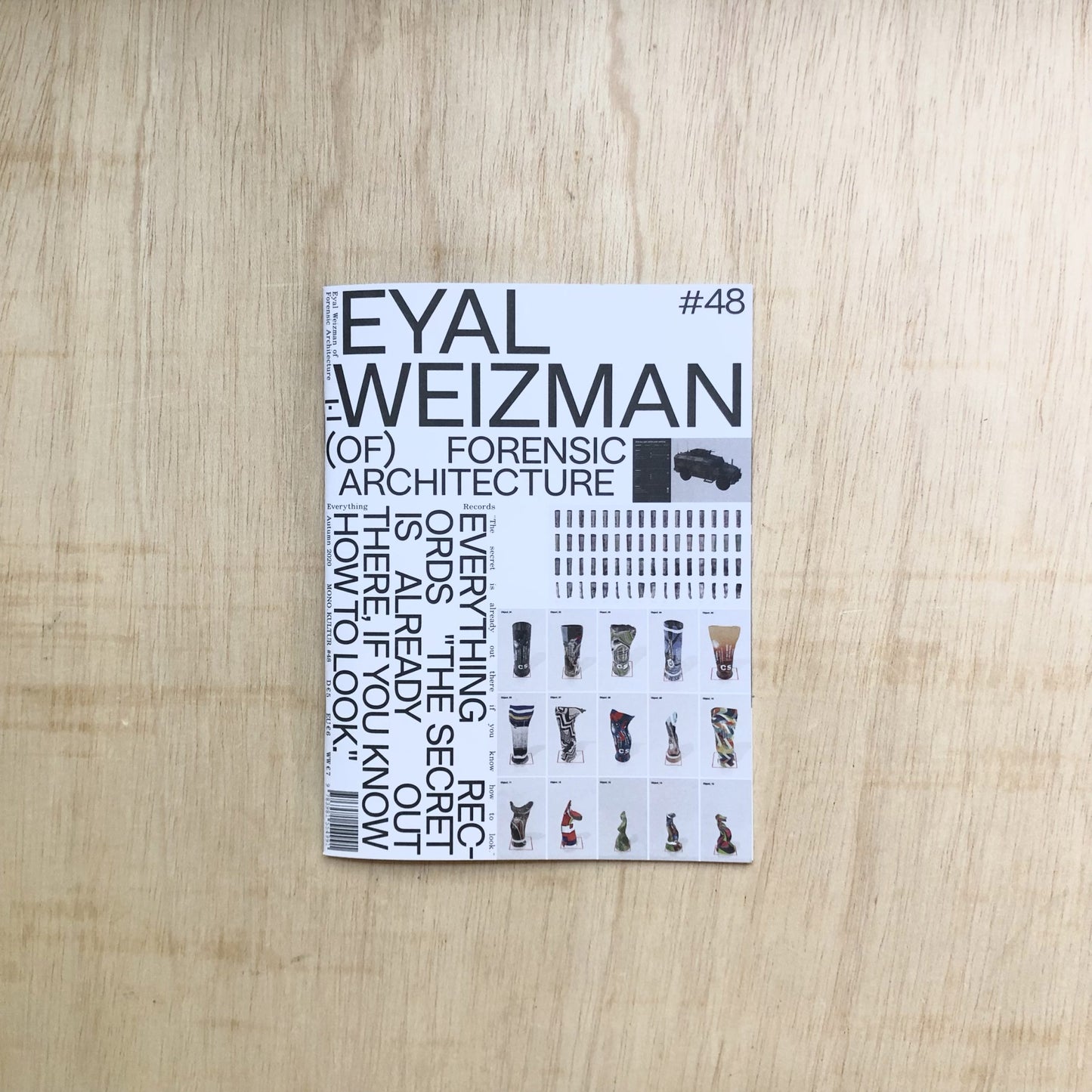Mono.kultur #48 - Eyal Weizman
Mono.kultur #48 - Eyal Weizman
mono.kultur
2020
Softcover
20 x 15 x 0.4
pages
Regular price
5,00 €
Regular price
Sale price
5,00 €
Unit price
per
Tax included.
Couldn't load pickup availability
From the ground, the object is seemingly innocuous. A kite, floating just above the horizon, its line stretched tight in the wind. It is only when it is reeled back that one can see the camera attached to it, held together using rubber bands and the neck of a plastic bottle.
Referred to as a ‘community satellite’, its images will be used in lieu of actual satellite imagery; filmed in areas above the Negev desert where Bedouin ownership of land is contested, and yet higher-resolution satellite images are withheld. The pictures show evidence of houses and other landmarks that point to Bedouin inhabitation prior to the founding of Israel in 1948. In an area where many Bedouin villages are illegalised, and routinely destroyed to make way for Jewish settlements, it is no small conclusion.
This makeshift satellite is just one of the many inventions from the group Forensic Architecture, a research agency based at Goldsmiths, University of London. Made up of architects, lawyers, journalists, scientists, and more, it is far from a conventional architectural practice; instead investigating human rights and environmental violations where the truth appears to have been distorted or covered up. In 10 years of work, they have investigated illegal detention sites in Cameroon, used oceanography to track a migrant boat adrift in NATO-surveilled waters, modelled a prison in Syria using victims’ memories of sound, and examined the causes and consequences of forest fires in Borneo and Sumatra. At its forefront is Eyal Weizman, a British Israeli architect.
Born in 1970 in Haifa, a city on Israel’s Mediterranean coast, Weizman studied at the Architectural Association in London before shifting his focus back to Israel. He had long been preoccupied with the country’s architecture and its complicity in the Israeli occupation, and in 2002 was invited with his colleague Rafi Segal to present the Israeli stand at the World Congress of Architecture in Berlin. They decided to exhibit models of Jewish settlements built in the occupied Palestinian territories. It was subsequently banned by the Israel Association of United Architects a month before the show, and as a response the pair published their material in a separate journal, with an exhibition in New York. It won Weizman international recognition and spoke of his projects to come: of his use of architecture as a means of investigation, and refusal to be silenced by those in a position of power.
Since then, Forensic Architecture has used a range of pioneering techniques, from reading the ‘fingerprints’ of smoke clouds left behind by missile strikes, to autopsying the path of toxic, crop-killing herbicides using fluid dynamics. Their research is used mainly as evidence in court cases and tribunals, and is often commissioned by victims and human rights associations. It has also leaked into the public spheres of museums and art exhibitions, such as the documenta 14 in Kassel, the Institute of Contemporary Arts in London, and the Manifesta in Palermo. In 2018, there was a controversial nomination for the Turner Prize. While art critics debated about the boundaries between political activism and fine arts, Weizman’s statement about the nomination was ambivalent: ‘I’d rather lose prizes and win cases.’
Such forays into the art world undoubtedly bring another dimension to the group’s work: namely, what happens when art has real-world consequences. In 2019, their contribution to the Whitney Biennial in New York caught the attention of the press. Forensic Architecture had presented an 11-minute film on a tear gas canister known as a Triple-Chaser, manufactured by a company called the Safariland Group and used throughout the world. This same company was owned by Warren B. Kanders – who was also the vice chair of the Whitney board. After months of protests, which saw Forensic Architecture and seven other artists withdraw from the biennial, Kanders reluctantly resigned from the Whitney.
Like the community satellites, Triple-Chaser and the countless other projects of Forensic Architecture have helped shed light on moments of violence and corruption. Architecture is used as a confluence of time, space, and context to gather evidence, painstakingly pieced together to provide fragments of truth. Whilst their work aims to correct injustices, it also helps victims process their loss and have it acknowledged on a public scale, forcing us to confront and address our systems’ failures and shortcomings.

